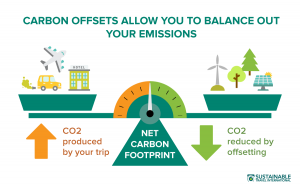According to the UN’s Intergovernmental Panel on Climate Change, countries around the world must reduce emissions by half of their 2010 levels by the year 2030 and achieve net-zero by 2050. However, emissions continue to rise at an accelerated rate. One solution many governments and corporations are adopting, including my most recent internship are known as carbon offsets, but how effective are these in reducing greenhouse gas emissions?

Carbon credits or offsets work by individuals or organizations paying an additional fee for any emissions they produce, which goes into projects that reduce carbon emissions.This is done either by reducing greenhouse gas emissions or increasing storage of carbon. The important point is that this is not done by the person purchasing the offset. The most common projects include planting trees, protecting forests, or providing alternative fuel sources. As of 2021, carbon offsets were a $1 billion industry, but it is not administered by any government or organization.
As someone who loves to travel the world, I am always wondering how I can reduce my impact given air travel is one of the heaviest emitting industries in the world. Nowadays, there are many carbon offset or carbon credit programs you can purchase along with your flight ticket to use your emissions as an investment into other, ideally regenerative solutions. One carbon offset credit represents an emissions reduction of 1 metric tonne of CO2 equivalent. However, numerous scientists and studies have been critical recently regarding the effectiveness of purchasing offsets. One common criticism is that carbon offsets don’t stop the root problem of heavy emissions. Bill Gates recently revealed he pays $7 million a year in offsets from his air travel yet continues flying around on a private jet.
Another critique is that often offsets don’t work as intended. Data from the Taskforce on Scaling Voluntary Carbon Markets found only 4% of offsets actively remove carbon from the atmosphere. In the EU, a carbon trading scheme known as the Clean Development Mechanism found that 85% of offsets were invested in programs unlikely to reduce emissions. 
To work, offsets must be used to create new, regenerative projects rather than only trade carbon by investing in existing ones. However, if we are to truly reach net-zero by 2050, we may need to tackle the emissions issue at its source, rather than simply throwing our money at others to make it go away.
Sources:
https://davidsuzuki.org/what-you-can-do/carbon-offsets/
https://www.washingtonpost.com/business/energy/what-are-carbon-offsets-and-how-many-really-work/2022/06/14/1741863c-ebdd-11ec-9f90-79df1fb28296_story.html
https://www.cbc.ca/radio/whatonearth/carbon-offsets-might-be-a-dangerous-distraction-from-more-effective-climate-action-experts-say-1.5946764
https://www.ipcc.ch/#:~:text=The%20Intergovernmental%20Panel%20on%20Climate%20Change%20(IPCC)%20is%20the%20United,science%20related%20to%20climate%20change.
ShreekavyaMittal
March 22, 2023 — 9:24 pm
Very interesting blog, Zach! I have often thought about carbon offsets and how they have become an easier answer for every corporation spewing carbon. It is really unfortunate to also witness the level of corruption in this process. As you mentioned, an industry like carbon offsets must have regulations and government control to ensure that there is some actual action!
emilynol
March 25, 2023 — 5:32 pm
Carbon offsets kind of feels the same to me as the US shipping its waste overseas. It is offsetting the problem to someone else who is either has an incentive to or is vulnerable to take it on. I think capping overall emissions helps, but I still feel like carbon offsets are a way for the rich to pay away their impact.
As mentioned in your post, the money should go back into regenerative energy not fossil fuels (I hope it is…). Then I am more comfortable with the idea of carbon offsets because the money goes into improving the core issue.
Muhammad Konain
March 26, 2023 — 9:55 pm
This is a really interesting article on carbon offsets and their effectiveness in reducing greenhouse gas emissions. It’s great to see that there are now many carbon offset or carbon credit programs available to consumers to help them reduce their carbon footprint, especially when it comes to air travel.
Muhammad Konain
March 26, 2023 — 9:56 pm
This is a really interesting article on carbon offsets and their effectiveness in reducing greenhouse gas emissions. It’s great to see that there are now many carbon offset or carbon credit programs available to consumers to help them reduce their carbon footprint, especially when it comes to air travel.